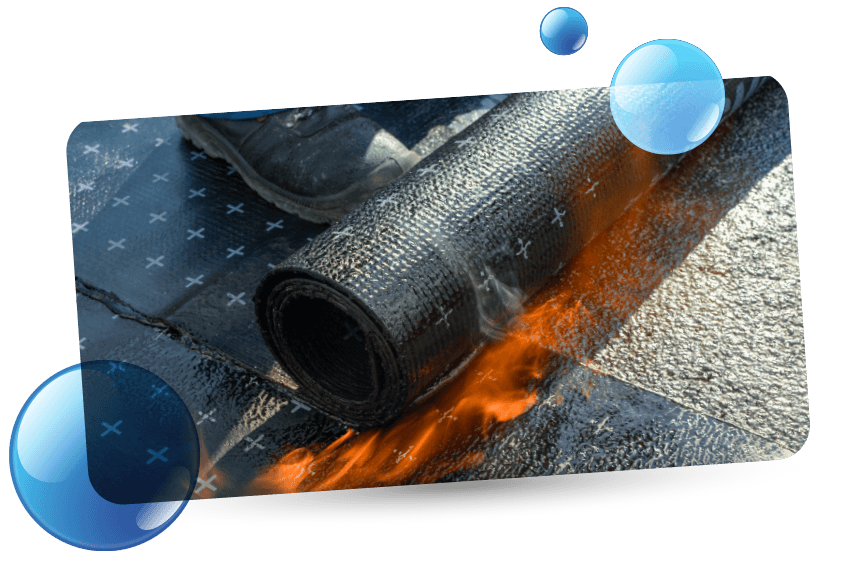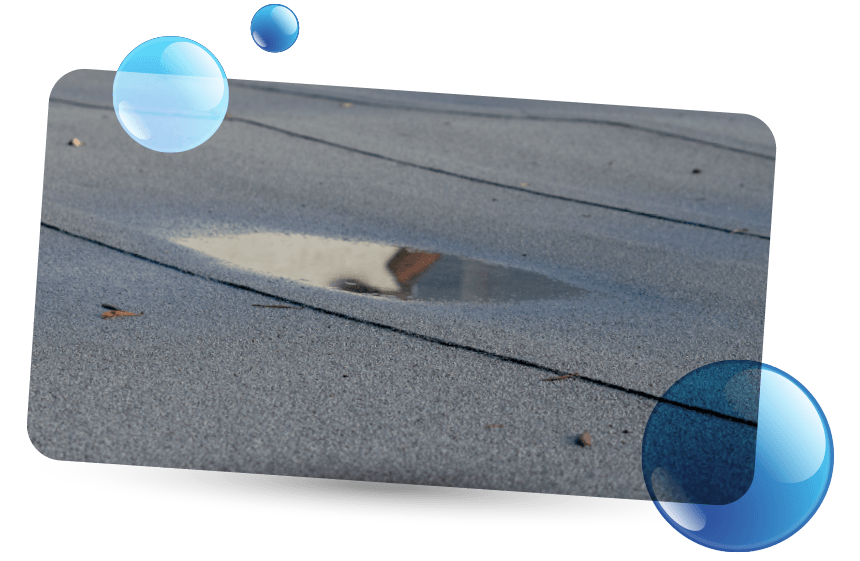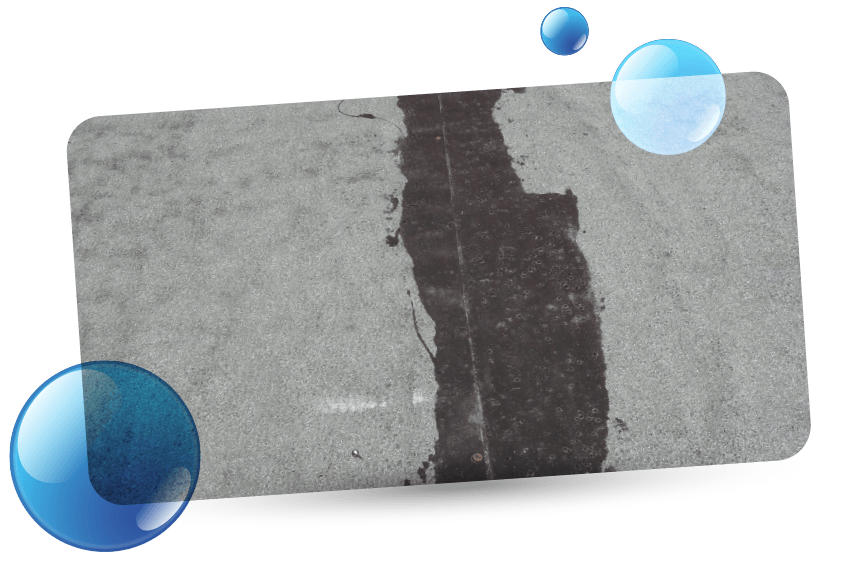How to Repair a Flat Roof
19/07/2022 00:00:00by Doug Kelley19/07/2022 00:00:00How to Repair a Flat RoofBluedrop Services
 Return to blog menu
Return to blog menu
In recent years, flat roofs have become increasingly popular because of their practicality and ease of installation and repair. However, they are often forgotten until leaks or visible damage make them impossible to ignore. Your roof is one of the most important parts of your house—keeping you and your possessions safe from weather and other external elements. To keep your roof in top condition, it's helpful to know how to repair a flat roof as well as how to maintain it.
Here's how to identify the signs that you need to repair your flat roof.Flat roofs do come with the added inconvenience of regular inspections and repairs because they're more susceptible to leaks than their sloped counterparts. This is because they don't offer complete protection against rainwater, which can collect on the roof if it's not properly drained away.
While most roofs are sloped steeply enough to keep water from pooling on them, flat roofs are designed with a gentle incline (between a quarter and half an inch per foot) that allows water to flow easily off the surface. However, if water accumulates, it can cause damage to your roof over time—and if you don't catch the problem in time, you might end up with an even bigger problem when it comes to time for a replacement.
It may be a little unsettling to think about the possibility of having to learn how to repair a flat roof, but the more you know, the better equipped you will be should the situation arise. Luckily, there are relatively simple ways to identify when to repair a flat roof, so you can address the issue before it becomes an expensive problem.
When to repair a flat roof
Interior water stains
Roof problems sometimes show up in the interior of your building. You may notice water stains on the walls or ceiling of upper floors, for example. This means it's time to investigate the problem and have it repaired before further damage occurs.
Cracking, blistering, or bubbling
Cracking, bubbling, and blistering are all indicators of moisture trapped beneath your flat roof's surface. In most cases, the sun heats the moisture, causing the membrane to expand and split, allowing water to seep into the structure and cause damage. Flat roofs have a lifespan of 10-15 years, so if you see these indicators, chances are it won't last much longer unless you repair it.
Water pooling

Water pooling on a roof can cause stress and pressure points, which lead to cracks over time. It is possible for flat roofs to tolerate some water gathering, but if the water doesn't drain properly, it will cause wear on the roof. Sometimes, moss, lichen, or algae can be a sign of water pooling.
Mould
You may notice mould and mildew accumulating on your roof over time in the form of stains, discoloured areas, or black spots. Moisture is one of the primary causes, and it can quickly find its way into your home's interiors. In addition, it may negatively affect the indoor air quality, leading to a variety of respiratory issues.
Damaged Flashing
Metal edge details, known as flashing, run along the perimeter of flat roofing systems, sealing joints and other areas regularly exposed to water. After many years of being exposed to the elements, this thin sheet of material can start to rust and pull away from the edges of your roof. If you ignore the problem, you may have to learn how to repair a flat roof sooner than expected.
Locating the problem
A flat roof is a great way to add an additional layer of living space to your house, but it's not without its perils. The lack of a pitched roof means there is nothing to hold back the heavy rainwater. This can lead to all sorts of problems like leaks, mould, and even structural damage if you don't take care of it in time.
Step 1: Check your home's interior and exterior roof for visible signs of water damage, such as cracks, punctures, or tears. Pay attention to the rubber seals around plumbing pipes, generators, air vents, and flashing. Check any drain pipes or vents you may have on your roof; those could be where it's coming in.
Step 2: Once located, you'll need to clear any debris, dirt, or excess water from your roof before proceeding further. Moss is particularly dangerous because it absorbs rainwater and transfers it to the layers underneath, causing decay or mould. This will compromise the structural integrity of your roof over time and must be removed immediately. Use a moss killer or sweep it away using a broom.Always prioritise safety!
When you're checking a flat roof for damage, it's important to keep safety in mind. When you're walking around on a roof looking for damage, look out for all possible hazards: broken or missing shingles, loose nails or other parts of the roof structure, protruding nails, loose flashing around vents and chimneys, standing water, uneven surfaces, etc.
If you don't know how to repair a flat roof, it's important that you hire someone with experience in flat roof repairs so they can fix it properly without adding more problems. A flat roof is made up of several layers: a waterproof membrane, insulation, structural deck, vapour control, ceiling joists, and finally your drywall; removing these layers can cause irreparable damage and lead to more leaks.
Repair a flat roof or replace it?
Most low-level roof repairs, like ponding and small leaks, can be accomplished without having to replace the entire roof. It is possible to learn how to repair a flat roof yourself, but we recommend seeking out an experienced roofing contractor. As a result, you'll be assured that your roof's issues are fixed properly, and any further issues can be identified.
You will want to consider repairing your flat roof if you are experiencing any of the following:- Leaks
- Missing shingles
- Pooling
- Holes
- Cracking
- Blistering
- Flashing
- Poor installation
- Weather damage
Roofs can be damaged by harsh weather conditions, worn out materials, and faulty workmanship. If your roof is experiencing damage that is beyond simple repair or is not a structural issue, then it may be necessary to replace the entire roof. It's usually best to repair issues first, but always consult with a trusted contractor about your options.
How to repair a flat roof when the roof is still in good condition
The repair procedure will be heavily determined by the type of flat roof you have. How to repair a flat roof will also widely depend on the damage caused.
1. Patching

You may be wondering if you can patch the affected areas of your roof rather than replace it entirely. Patching a smaller damaged area can work in some cases. Patching a section of a flat roof, on the other hand, is only effective if moisture damage has not yet spread to the foundational roof deck or surrounding areas.
2. Roof re-covering
Roof re-covering is a second option for avoiding flat roof replacement. This is the process of installing a new membrane (such as EPDM or TPO) on top of your existing flat roof without removing the damaged materials. Roof re-covering can be effective in situations where the roof is not leaking or severely damaged, but shows clear signs of ageing or minor deterioration.
3. Roof coating
Roof coating is similar to roof re-covering. Coating your roof involves applying a thin liquid membrane over the existing roof. Taking this proactive measure is a good idea if your roof doesn't show extensive damage already. Adding a roof coating can increase the heat and UV resistance of your roof membrane. Roof coating will only work best when there are no insulation issues or underlying structural problems.
Popular flat roof materials
When learning how to repair a flat roof, it is essential to use suitable materials. It will also affect the look of your home, its efficiency, and its overall durability. There are four main types of materials that are used for flat roofs:
Fibreglass GRP
Despite their higher cost, fibreglass roofs are the most durable and easy to maintain. They are also the most expensive due to the material costs, but they are also inherently more resistant to damage and require almost no maintenance.
EPDM Rubber
The black rubber membrane EPDM (ethylene propylene diene terpolymer) is commonly used in commercial, industrial, and medical facilities. While the material is primarily used in commercial roofing, it also has its place in residential roofing.
TPO membrane roofing
Thermoplastic polyolefin, or TPO, is a single-ply white membrane, popular in both commercial and residential roofing. Unlike EPDM, it reflects heat rather than absorbs it.
PVC membrane roofing
Very similar to TPO, PVC (polyvinyl chloride) is also a single-ply white membrane used in commercial and residential roofing. PVC is also an excellent choice for flats or low-sloped roofs over a living room or bedroom.
In general, flat roofs are becoming more and more popular, which is both good and bad news for the home owner. Firstly, flat roofs are easier to construct than slanted roofs, so it's cheaper to build them. However, flat roofs as we can see in this article have some distinct issues of their own. Knowing how to repair a flat roof can be beneficial and save you money in the long run.
Call our friendly team now for the right insurance cover - at the best price
+441489780491
Calls recorded for training and quality.



 Privacy and Cookie Policy
Privacy and Cookie Policy